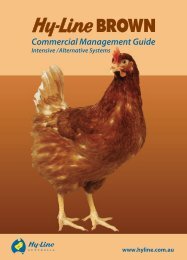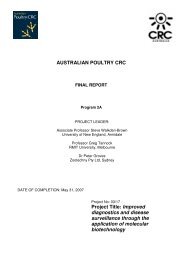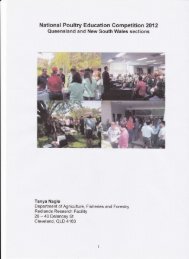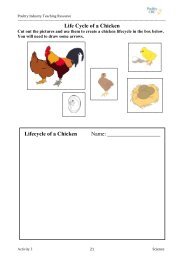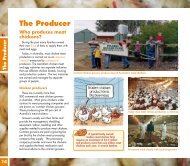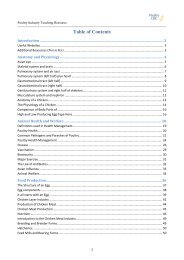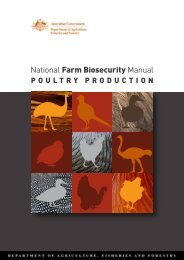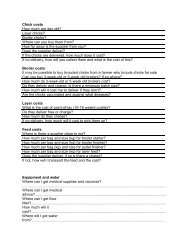You also want an ePaper? Increase the reach of your titles
YUMPU automatically turns print PDFs into web optimized ePapers that Google loves.
2.3.1 TreatmentsA semi-purified diet consisting of 75 % sorghum and 12 % isolated soy protein was formulated. Priorto processing, the sorghum was sieved to remove excess debris and dust. Four treatments, differing inmean particle size and processing method used to modify the sorghum grain were compared.Treatments were based on sorghum processing type before pelleting and are described by method ofmilling, if any, and were as follows: Whole sorghum (WS); Hammer-mill – 3.0 mm screen (HM3);Roller-mill – 0.15 mm roller spacing (RM0.15), and Hammer-mill – 1.0 mm screen (HM1).Diet 3 (RM0.15) was ground to have a mean equivalent particle size of Diet 2 (HM3). Diets „WS‟ and„HM1‟ were used to represent extreme variations from the intermediate particle sizes used in dietsHM3 and RM0.15. The HM3 diet was used as a control, based on current processing methods used infeed milling. All dietary treatments were manufactured using the same formulation, which was semipurifiedto reduce the confounding effects of other factors, and excluded the use of antibiotics/growthpromotants and coccidiostats.2.3.2 Feed preparationAfter sieving, the sorghum needed for the experiment was divided into four portions corresponding tothe four treatments. After a 1mm screen was fitted to a commercially used 18.5kW hammermill(Münch-Edelstahl, Wuppertal, Germany, licensed by Bliss, USA), one portion of sorghum was fedthrough the machine to yield the sorghum used for diet treatment 4 (HM1). The same hammer-millwas then fitted with a 3 mm screen, and a second portion of sorghum was fed through the mill to yieldthe sorghum component for diet treatment 2 (HM3). A representative sample of the HM3 was takenand dry sieved using a Retsch AS 200 (F. Kurt Retsch GmbH & Co., Haan, Germany) and the meanparticle size calculated.Using trial and error, the two sets of a commercial 13kW roller-mill (Model DP 900-12, Roskamp,Indiana, USA) were adjusted to yield an equivalent mean sorghum particle size to the HM3 sorghum.The roller spacings were 0.15 mm at the top rollers and 0.15 mm at the bottom rollers. The resultingmilled sorghum was used in the third dietary treatment (RM0.15). The sorghum for the first treatmentwas left unprocessed prior to mixing. All dietary components, except for soy oil, were added to thesorghum and mixed thoroughly using a Dinnisen mixer (Pegasus Menger 400 1, Sevenum, Holland).All diets were steam-conditioned in a double conditioner (Münch-Edelstahl, Wuppertal, Germany) for60 seconds at an average conditioning temperature of 75˚C, and soy oil was added at this stage. Thediets were then steam-pelleted (Münch-Edelstahl, Wuppertal, Germany, RMP 350,100, 5000kg.h -1capacity) using a 3 mm die (42mm thick). The pellet press had two closed-end corrugated rolls set atapproximately 0.25 mm to the inner surface of the pellet die. For each diet, a pellet sample was takenimmediately as the pellets fell from the press and stored in a polystyrene box fitted with an electronicthermometer to measure post-pelleting temperature. All diets were cooled after pelleting in a MiltenzCounter Flow Cooler (Auckland, New Zealand, 2000kg.h -1 capacity). Average post-pelletingtemperatures, energy consumption and production rates of the pellet press of the four diets arepresented in Table 2.1.Table 2.1: Production characteristics of the four sorghum diets through a commercial steamconditioner and pellet press (Experiment one).Treatment WS HM3 RM0.15 HM1Pellet temperature ( o C) 83.9 82.3 81.8 84.0Power consumption (A) 83.9 82.3 81.8 84.0Production rate (kg/hr) 750-800 800 800 800Feeder rate (%) 40-45 45-50 45-50 45-509



